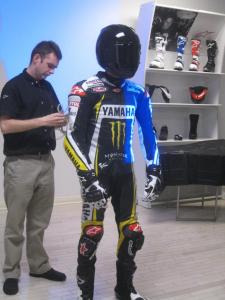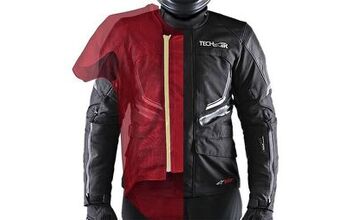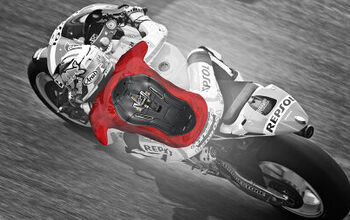2010 Alpinestars Electronic Airbag Technology
Get the Flash Player to see this player.
In January, Dainese announced details of its new D-Air suit replete with airbags in the shoulder areas to mitigate common injuries from motorcycle roadracing crashes.
Now Alpinestars, a fellow Italian gear producer, reveals its similar solution for racers: the A-stars Electronic Airbag Technology.
It was a decade ago when Alpinestars began working on an airbag solution for motorcyclists, and these early examples were exterior inflatable vests that envelope riders when activated. Something similar may come from A-stars in the future, but the first consumer implementation of airbags will be for roadracing use.
MotoGP riders Ben Spies, Mika Kalio and Dani Pedrosa are currently using the A-Stars airbag system. Rather than a bulky enveloping system, Alpinestars’ operational suit concentrates on the areas of the body most commonly damaged in a roadrace crash. According to A-stars data, nearly 50% of racing crashes cause injuries to the shoulder and collar-bone zones of the body.
"MotoGP riders Ben Spies, Mika Kalio and Dani Pedrosa are currently using the A-Stars airbag system."
Focusing on these specific areas has allowed A-stars to package the complete system unobtrusively into a set of leathers, with an airbag in each shoulder and a sophisticated electronics brain stashed in the suit’s neck hump. Complete with its multitude of sensors inside the suit, the complete system is said to add about 500 grams of weight compared Dainese’s D-Air weight penalty of 700-750 grams.
Despite the system’s diminutive size, A-stars says that a 19 kilo-newton shoulder impact is drastically reduced to just 2.2 KN of force with the airbags deployed. This could easily be the difference between bouncing up after a crash to continue a race/season or making a painful trip to the hospital in advance of a lengthy recuperation period.
Brain Power
The biggest hurdle of designing an autonomous airbag system is defining in certain terms what constitutes a crash. An airbag that deploys before a rider needs it is not only useless, it could also compromise control.
Early airbag triggers were often a simple tether that activated deployment when the rider separated from the motorcycle. This worked adequately when, say, a rider T-boned a car, but it presents operational problems such as when dismounting the bike and forgetting about the tether, causing the bags to pointlessly deploy. Or when experiencing a highside that is able to be saved.
Eschewing the tether idea, Alpinestars has created an intelligent system that uses seven sensors (including accelerometers) placed within the suit to determine “the overall behavior of the body,” according to Colin Valentine, Alpinestars senior engineer for the airbag project.
For example, the arming system isn’t activated unless the sensors confirm the suit’s wearer is in a riding position and is physically moving. The airbag’s brain also detects if the motorcycle is running by vibration sensors. A sophisticated algorithm process ensures several stages of protocols are met before determining a crash is underway and the airbags get deployed.
The decision to fire takes only 0.02 second (20 milliseconds), and the bags require just 0.05 second to inflate via a very small pyrotechnic charge that fires compressed nitrogen gas into the airbag bladders at about 15 psi. The bladders remain inflated for 5 seconds before gradually releasing pressure. Unlike Dainese D-Air, the A-stars system is able to reload itself for a second crash, being able to refire itself as soon as one minute after initial deployment should a racer be exceedingly unfortunate.
A GPS is part of the electronics system, but it isn’t used to arm or disarm the system because its signal can’t be trusted 100% of the time. Instead it is used solely for analysis.
As development continues, Alpinestars is expecting to have early consumer systems available in the summer of 2011. These versions will be armed by moving the suit’s zipper into its closed position, and the only maintenance required will be to ensure the battery is charged before use.
Early adopters will have to pony up about $2,500 on top of the cost of a suit when the airbags become available in about a year.
A street version has been undergoing parallel development with the race suit, but 2012 is the soonest it will hit the marketplace. We’re told to expect an external system for the street, which will enable it to utilize multiple airbags for more comprehensive protection in a crash, similar to what we were told about the upcoming Dainese street system. A version for motocross use will eventually follow.
So, just as Ducati and Aprilia duel it out for World Superbike race supremacy, so too do Alpinestars and Dainese in their own Italian battle to become the first to market with an airbag-equipped suit. The ability of the A-stars system to operate autonomously gives it an advantage over what we know of the existing D-Air setup, but it will be interesting to see the differences between the similar concepts once they get into the hands of consumers. The eventual costs of such systems will be a key component of the equation.
More by Kevin Duke
































Comments
Join the conversation